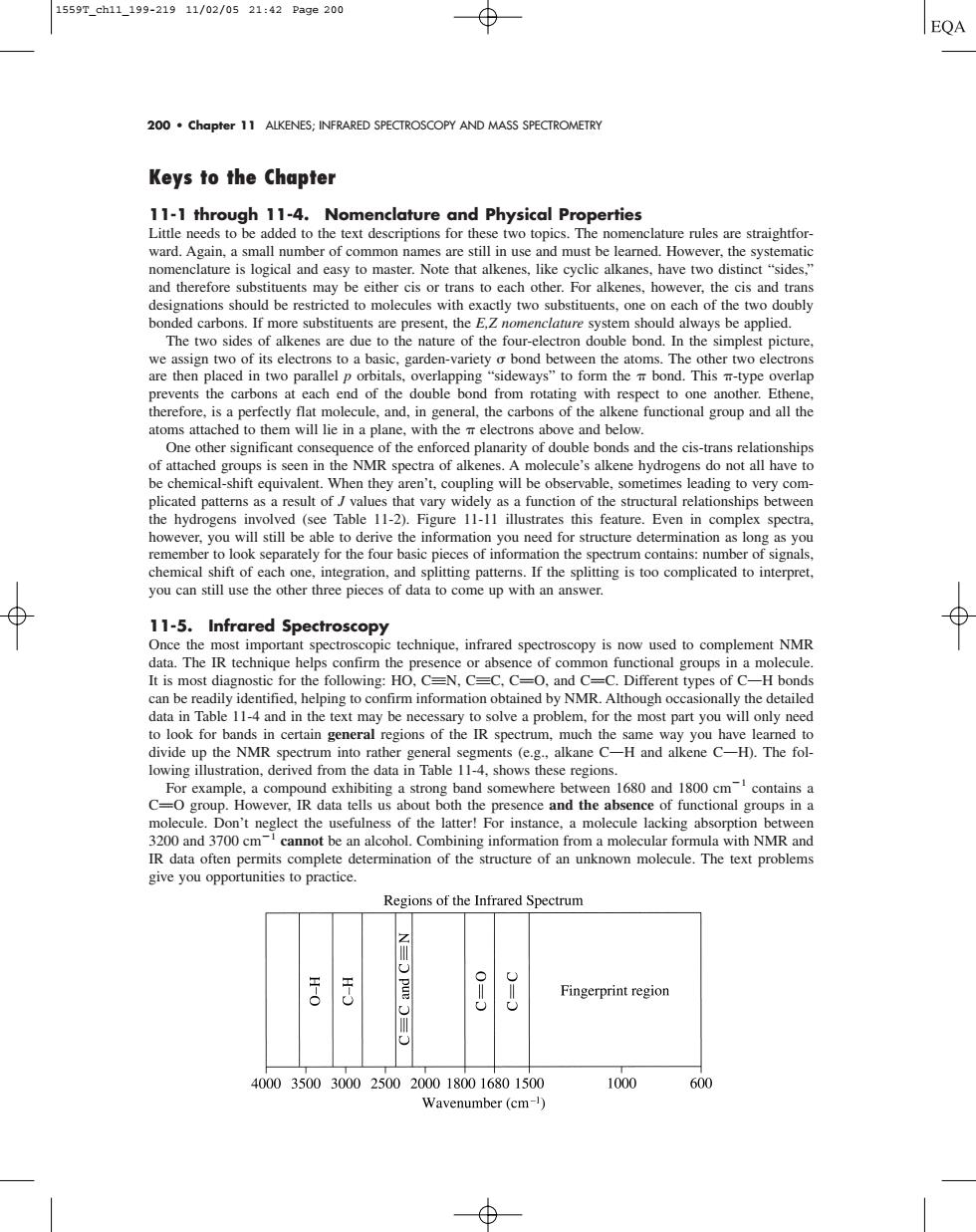正在加载图片...

15597ch11199-21911/02/0521:42Page200 EQA 200.Chapter 11 ALKENES:INFRARED SPECTROSCOPY AND MASS SPECTROMETRY Keys to the Chapter 11-1 thro ough 11-4. Nomenclature and Physical Propertie traightfor nomenclature is logical and easy to master.Note that alkenes,like cyclic alkanes.have two distinct"sides. either cis or trans to za之 and therefore su may b or alkenes,howe The two sid ol a enes are due to the nature o the I ectron double bond. n simplest picture pe overlap nioalgpah One other significant consequence of the enforced planarity of double bonds and the cis-trans relationships Ik spectra or al molecule's a do not all have to plicated patterns as a result of values that vary widely as a function of the structural relationships between e Tab remember separatelyfor the four basic pieces of the spectrum of signa to come up with an answe 11-5.Infrared Spectroscopy opic technique.infrared spectroscopy is now used to complement NMR can be readily identified.helping to confirm information obtained by NMR.Although occasionally the detailed and in text may be ne oive a problem.t r the most pant you gments (e.g..alkane C-H and alkene C-H).The fol- esence and the absence of functional groups in a mocDon'the of the latter!For instance.a molecule lacking absorption etwe give you opportunities to practice. Regions of the Infrared Spectrum pue Fingerprint region 4000 350030002500 20001800 1680150 1000 Wavenumber(cm-)200 • Chapter 11 ALKENES; INFRARED SPECTROSCOPY AND MASS SPECTROMETRY Keys to the Chapter 11-1 through 11-4. Nomenclature and Physical Properties Little needs to be added to the text descriptions for these two topics. The nomenclature rules are straightforward. Again, a small number of common names are still in use and must be learned. However, the systematic nomenclature is logical and easy to master. Note that alkenes, like cyclic alkanes, have two distinct “sides,” and therefore substituents may be either cis or trans to each other. For alkenes, however, the cis and trans designations should be restricted to molecules with exactly two substituents, one on each of the two doubly bonded carbons. If more substituents are present, the E,Z nomenclature system should always be applied. The two sides of alkenes are due to the nature of the four-electron double bond. In the simplest picture, we assign two of its electrons to a basic, garden-variety bond between the atoms. The other two electrons are then placed in two parallel p orbitals, overlapping “sideways” to form the bond. This -type overlap prevents the carbons at each end of the double bond from rotating with respect to one another. Ethene, therefore, is a perfectly flat molecule, and, in general, the carbons of the alkene functional group and all the atoms attached to them will lie in a plane, with the electrons above and below. One other significant consequence of the enforced planarity of double bonds and the cis-trans relationships of attached groups is seen in the NMR spectra of alkenes. A molecule’s alkene hydrogens do not all have to be chemical-shift equivalent. When they aren’t, coupling will be observable, sometimes leading to very complicated patterns as a result of J values that vary widely as a function of the structural relationships between the hydrogens involved (see Table 11-2). Figure 11-11 illustrates this feature. Even in complex spectra, however, you will still be able to derive the information you need for structure determination as long as you remember to look separately for the four basic pieces of information the spectrum contains: number of signals, chemical shift of each one, integration, and splitting patterns. If the splitting is too complicated to interpret, you can still use the other three pieces of data to come up with an answer. 11-5. Infrared Spectroscopy Once the most important spectroscopic technique, infrared spectroscopy is now used to complement NMR data. The IR technique helps confirm the presence or absence of common functional groups in a molecule. It is most diagnostic for the following: HO, CqN, CqC, CPO, and CPC. Different types of COH bonds can be readily identified, helping to confirm information obtained by NMR. Although occasionally the detailed data in Table 11-4 and in the text may be necessary to solve a problem, for the most part you will only need to look for bands in certain general regions of the IR spectrum, much the same way you have learned to divide up the NMR spectrum into rather general segments (e.g., alkane COH and alkene COH). The following illustration, derived from the data in Table 11-4, shows these regions. For example, a compound exhibiting a strong band somewhere between 1680 and 1800 cm1 contains a CPO group. However, IR data tells us about both the presence and the absence of functional groups in a molecule. Don’t neglect the usefulness of the latter! For instance, a molecule lacking absorption between 3200 and 3700 cm1 cannot be an alcohol. Combining information from a molecular formula with NMR and IR data often permits complete determination of the structure of an unknown molecule. The text problems give you opportunities to practice. 1559T_ch11_199-219 11/02/05 21:42 Page 200���